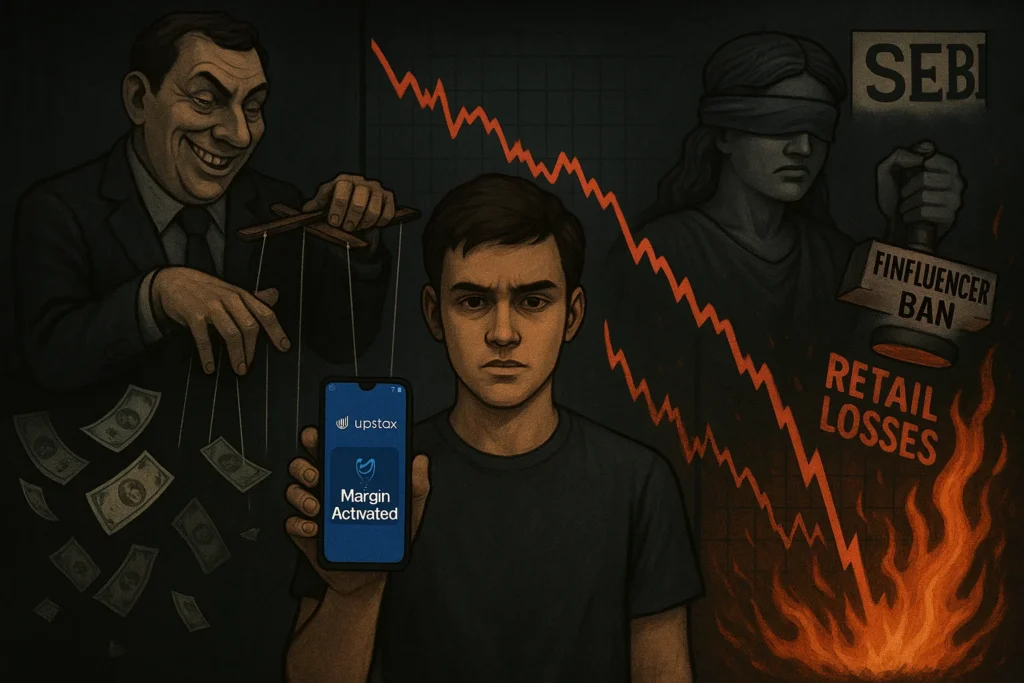Introduction – The Rise of Easy Margin Access
In recent years, brokers have rolled out a shiny new feature that promises retail investors more buying power—margin trading facilities. With just a few taps on a mobile app, even first-time investors can pledge shares and receive additional funds to buy more stocks. No physical paperwork, no delay—just instant leverage.
This wave of convenience has made margin trading dangerously popular, especially among new investors hungry for quick gains. With advertisements highlighting “1-click pledge,” “increase buying power,” and “earn more from your portfolio,” brokers have gamified the process of borrowing against one’s own investments.
Unfortunately, this isn’t financial empowerment—it’s a Broker Margin Trading Trap. Most retail investors don’t understand what they’re stepping into until it’s too late. They see it as a shortcut to higher returns, but in reality, it’s a gateway to debt, distress, and forced selling.
How the Margin Trading Facility Works
The mechanism appears simple—too simple, in fact. Here’s how the broker margin trading trap lures investors:
You own a few shares in your Demat account. The broker offers you an option to pledge those shares as collateral. Once pledged, the broker gives you margin money—essentially a loan—based on the value of those shares. You can now use this borrowed amount to buy more stocks.
But here’s the catch: brokers charge interest on that borrowed amount. Some of them bury this cost in fine print or add platform and processing fees. While you hold the new shares, your pledged assets stay locked with the broker as security.
For example, suppose you have ₹1,00,000 in shares. You pledge them and get ₹70,000 as margin. You buy more stocks with it. If the market rises, you gain. But if it falls even slightly, your total portfolio starts bleeding—and the broker doesn’t wait for your recovery.
That’s the hidden danger: the facility encourages over-leverage and pushes investors into making high-risk bets they may not understand.
Why It Looks Attractive – But Isn’t
At first glance, margin trading feels like an investor’s dream. You get more capital, take larger positions, and potentially earn more. Brokers fuel this illusion with phrases like “double your gains” and “unlock the full potential of your portfolio.”
It sounds smart. Efficient. Even advanced. But it’s anything but.
This false sense of control is one of the biggest risks in the broker margin trading trap. Apps and platforms don’t just allow margin—they push it. Investors get notifications saying they have unused margin available. They’re nudged to use it instantly.
The platforms never emphasize the downside—what happens if the stock drops by even 10%? The margin loan remains, interest continues, and you now sit on a leveraged loss. Brokers celebrate when you trade more. Your risk is their revenue.
The Real Risk: Debt, Margin Calls & Forced Selling
When stock prices fall—and they often do—things spiral quickly.
The moment your portfolio value drops below a threshold, the broker issues a margin call. You must either bring in more money or pledge more shares. Most investors aren’t prepared for this. When they don’t respond in time, the broker sells off the pledged shares automatically—often at a loss.
In this process, you not only lose the newly bought shares but also your original holdings. The worst part? You never fully control when or how these shares are sold.
That’s the cruel core of the broker margin trading trap—retail investors unknowingly borrow their way into volatility, and when the market corrects, they’re wiped out.
What brokers pitch as financial flexibility is really a fast-track to forced liquidation. Your investments get cannibalised in the name of leverage.
Critique of Brokers – Pushing Risky Products to Newbies
Brokers don’t offer margin out of generosity—they profit from it. Every time an investor pledges shares and uses margin, the broker earns interest on the borrowed funds and gets a cut from increased trading volumes.
The more you borrow, the more you trade. The more you trade, the more fees they collect. That’s the business model hiding behind the promise of “financial empowerment.”
Mobile apps constantly highlight “available margin” and “boost your buying power” messages. Some platforms even auto-check the margin box by default when you place an order. The marketing targets new, excited investors who don’t understand the consequences.
Yet, these platforms barely explain the risks of pledging shares—no warnings, no education, no simulation of how fast a small dip can lead to forced liquidation. Brokers actively push a complex, high-risk product under the guise of accessibility.
This is not innovation. This is exploitation. The Broker Margin Trading Trap isn’t just allowed—it’s aggressively promoted to those least prepared to handle its risk.
SEBI’s Contradiction – Silencing Finfluencers, Empowering Debt Traps
SEBI claims to protect retail investors. It bans financial influencers, restricts educational content, and regulates online creators in the name of investor safety. But ironically, it gives brokers free rein to trap those very investors in leveraged debt.
On one hand, SEBI attacks finfluencers for making “unauthorised” stock tips. On the other, it permits margin trading schemes that systematically harm inexperienced traders—without enforcing proper risk disclosures.
There’s a clear regulatory gap. SEBI mandates detailed warnings on mutual funds and derivatives but remains silent on mobile-based margin facilities. Brokers can offer high-risk leverage products with no mandatory tutorials, no cooling-off periods, and no risk assessment checks.
If SEBI truly intends to safeguard the retail segment, it must confront the Broker Margin Trading Trap head-on—not just silence critics and educators.
The Psychological Trap – Greed and Overconfidence
Leverage plays to the worst instincts of new investors. A few good trades lead to a false sense of mastery. They see green on their portfolio screen, feel invincible, and fall straight into the margin trap.
Recency bias from recent bull runs reinforces risky behavior. Investors believe markets always recover, so doubling down feels safe. Margin offers the illusion of control, when in reality, it amplifies every mistake.
A simple 5% market dip with borrowed funds can turn into a 25% loss. The math works against you. But greed blinds judgment. And overconfidence pushes retail investors to risk more than they can afford.
Apps don’t just enable this—they fuel it with gamified interfaces and celebratory graphics. The Broker Margin Trading Trap is as much psychological as it is financial. Once caught, it’s difficult to escape without losses.
Case Study: How One Investor Lost His Portfolio to Margin
Meet Rahul, a 26-year-old first-time investor. He started with ₹1 lakh, encouraged by rising markets and success stories on YouTube. His broker app offered margin against his holdings—no paperwork, no questions asked.
He pledged his entire ₹1 lakh portfolio and received ₹70,000 as margin. Excited by the increased buying power, he used it all. But the market corrected just 6% in two weeks. His total holdings fell below the broker’s margin threshold.
Before Rahul could react, the broker liquidated his pledged shares. The app showed a “margin shortfall,” but he didn’t understand the urgency. Within three weeks, he lost over 80% of his portfolio—not from bad stock selection, but from the mechanics of leverage.
His original investment, his new purchases—everything was gone. No phone call, no support, just a cold email confirming liquidation.
This story isn’t unique. It’s the silent crisis unfolding across India’s growing retail segment. Rahul isn’t reckless—he’s uninformed. And the system designed to educate and protect him failed.
What SEBI Should Do Instead
If SEBI truly wants to protect retail investors, it must take real action—not just symbolic bans on content creators. Margin trading cannot remain a backdoor trap dressed as a platform “feature.”
Before allowing margin access, brokers must present detailed, mandatory risk disclosures. Not in fine print. Not in legal jargon. In plain, visual language that shows the exact outcomes of leverage in falling markets.
Investor education must become non-negotiable. SEBI should enforce a cooling-off period for first-time margin users—just like insurance policies. No one should get instant access to leverage without proper training or simulated risk exposure.
Brokers must clearly display their interest rates, margin call triggers, and liquidation timelines. These cannot be buried in PDFs or complex dashboards.
The Broker Margin Trading Trap only exists because regulators look the other way. It’s time for that to change. Enforcement must go beyond influencers and start holding platforms accountable.
What Retail Investors Must Understand
If you’re a retail investor, here’s the uncomfortable truth: Margin is not your friend. It doesn’t make you richer—it just makes you more vulnerable.
Never pledge your core holdings just to buy more stock. What you “own” today becomes the broker’s collateral tomorrow. A small dip in stock prices can lead to total loss without warning.
Margin gives the illusion of financial muscle. But in volatile markets, it’s a double-edged sword—and retail investors always bleed first.
Your best tool isn’t leverage—it’s patience. Real wealth is built slowly, through consistent investing, diversification, and discipline. Not by borrowing from brokers who profit off your risk.
Avoid products that feel too easy or exciting. If it takes one click to double your portfolio size, that’s a red flag—not a feature.
The Broker Margin Trading Trap has only one winner—and it isn’t you.
Final Verdict – Margin Trading is a Trap, Not a Tool
Let’s call it what it is: Margin trading isn’t financial empowerment—it’s a trap engineered for broker profits.
Brokers win by collecting interest. SEBI watches passively, enforcing silence on educators while letting high-risk products run wild. And retail investors? They lose their portfolios, their capital, and often, their trust in markets.
The rise of digital platforms has made margin access dangerously easy. With no education, no safeguards, and no transparency, the current system isn’t just flawed—it’s predatory.
If SEBI truly cares about protecting the investor class, it must regulate or restrict margin trading access, especially for first-time and young investors. Until then, every new user is one click away from becoming the next victim of the Broker Margin Trading Trap.
FAQs: Broker Margin Trading Trap
What is the Broker Margin Trading Trap?
The Broker Margin Trading Trap refers to the deceptive ease of using borrowed money to buy shares, leading to hidden risks, interest charges, and potential portfolio losses.
How do brokers trap investors with margin trading?
Brokers offer instant margin access and promote it as a smart feature, hiding the dangers of debt, margin calls, and forced liquidations during market dips.
Why is margin trading risky for retail investors?
Retail investors often pledge core holdings for leverage, and when stock prices fall, brokers liquidate positions without consent—leading to large losses.
Do brokers clearly disclose the risks involved?
Most brokers highlight the benefits but downplay risks. They rarely show how interest compounds or how margin calls can wipe out a portfolio quickly.
Can margin trading wipe out all my investments?
Yes. A 10–15% drop in stock price can trigger a margin call, forcing brokers to sell both pledged and purchased stocks—causing total loss.
Why is SEBI allowing such risky products?
Despite banning financial influencers for investor protection, SEBI allows margin trading without strong risk disclosure mandates—creating a regulatory contradiction.
Is margin trading suitable for new investors?
No. Margin trading demands deep market understanding, risk tolerance, and discipline. Most new investors fall into the trap due to overconfidence and inexperience.
What should I do instead of using margin?
Invest steadily in quality stocks, avoid leverage, and use SIPs or long-term equity funds. Real wealth builds over time—not through risky shortcuts.
Do all brokers offer margin trading by default?
Many brokers enable margin trading with minimal user action. Users often don’t realize they’ve opted in until it’s too late.
How can I avoid the Broker Margin Trading Trap?
Disable margin access in your broker account, never pledge long-term holdings, and always read the interest and liquidation terms before using any margin feature.
Related Articles
India’s $40 Billion Spending Wave: What’s Powering the Next Consumption Boom?
Battery Energy Storage in India: The $32 Billion Opportunity Powering the Green Shift
Power Sector Boom in India: Stocks to Watch and Why It’s Just Beginning
Vehicle-to-Grid (V2G) Technology: How India Is Gearing Up and 5 Stocks to Watch






